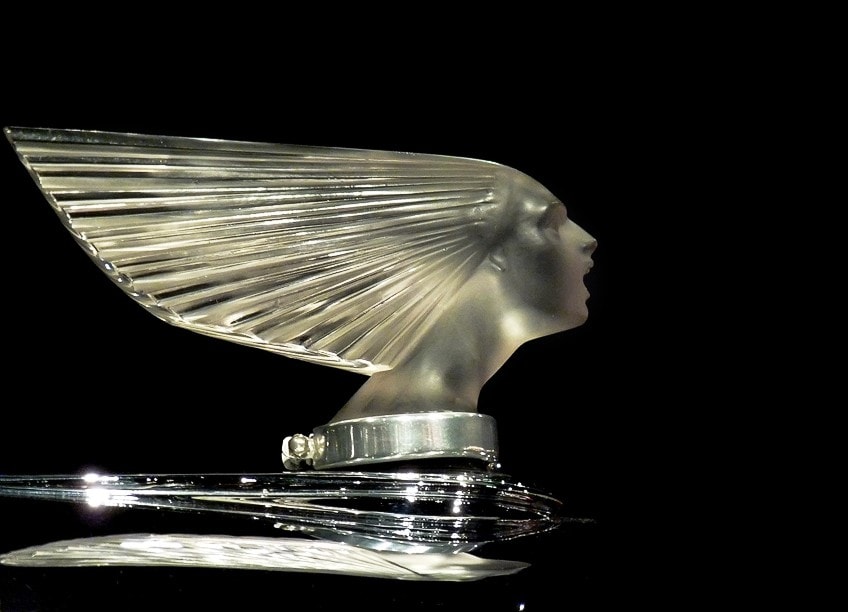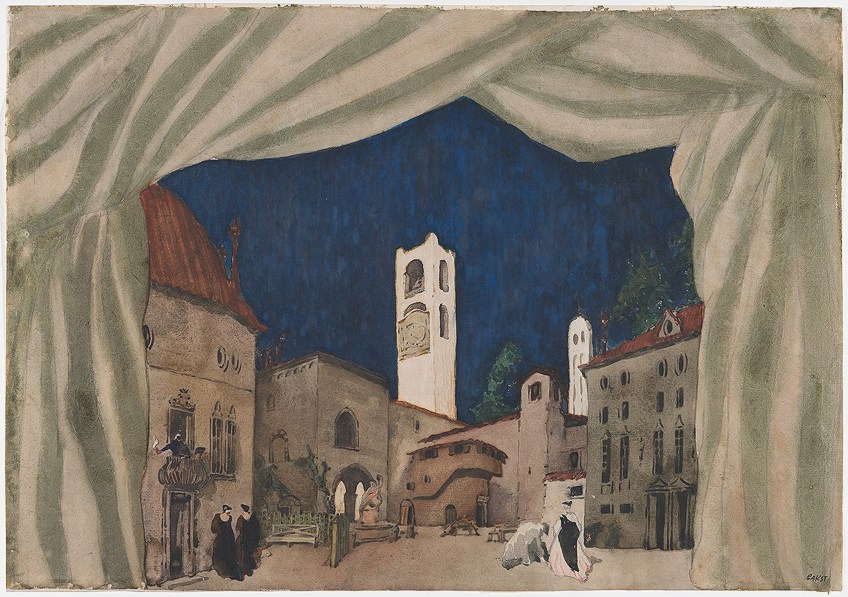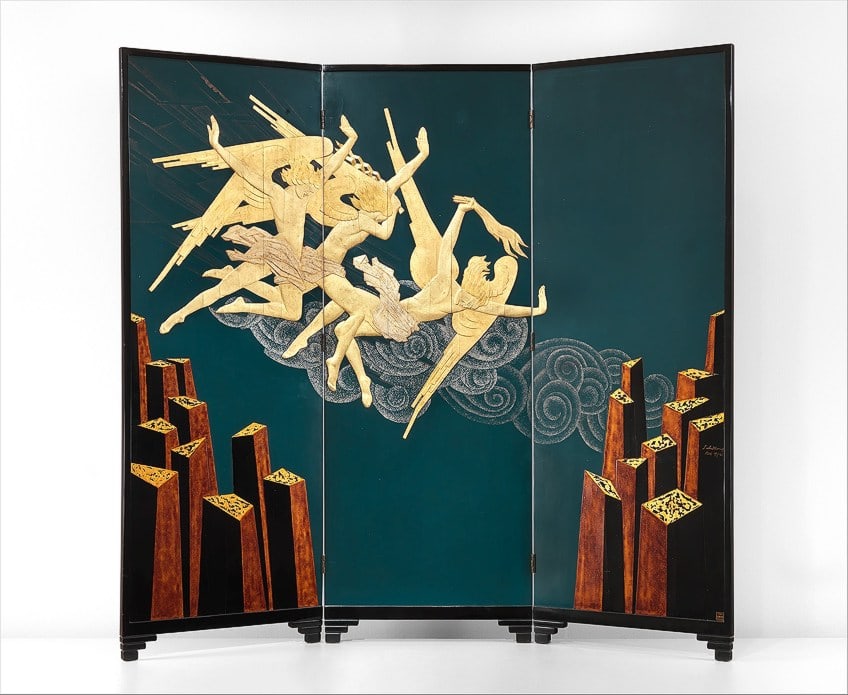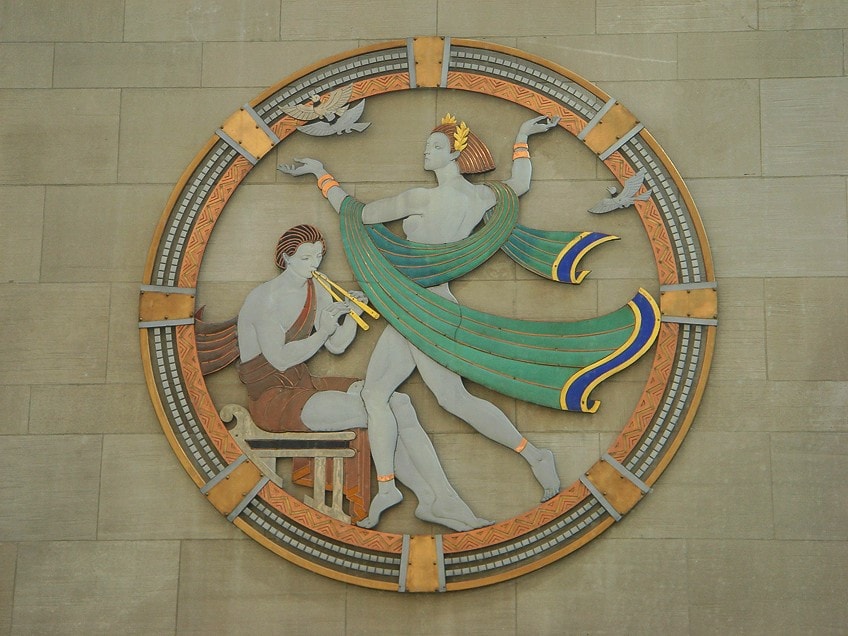Famous Art Deco Artists – The Best Art Deco Designers to Know
Art Deco was one of the most graceful and elegant genres in contemporary art history during its peak years between the two major global wars. It was an aesthetic that was adopted by many creative people from Art Deco painters and jewelers to Art Deco designers and architects. In this article, we will look at the influential Art Deco names that pioneered the style with our list of famous Art Deco artists.
Contents
- 1 Famous Art Deco Artists
- 1.1 René Lalique (1860 – 1945)
- 1.2 Léon Bakst (1866 – 1924)
- 1.3 Jean Dunand (1877 – 1942)
- 1.4 Émile-Jacques Ruhlmann (1879 – 1933)
- 1.5 Sonia Delaunay (1885 – 1979)
- 1.6 Demétre Chiparus (1886 – 1947)
- 1.7 Le Corbusier (1887 – 1965)
- 1.8 Georges Lepape (1887 – 1971)
- 1.9 Hildreth Meière (1892 – 1961)
- 1.10 Romain de Tirtoff (Erté) (1892 – 1990)
- 1.11 Tamara de Lempicka (1898 – 1980)
- 2 Frequently Asked Questions
Famous Art Deco Artists
Art Deco designs were synonymous with progressive concepts of modernity, exuberant celebrations of life, and the extravagant lifestyle of a postwar generation of youth. Art Deco ideals and aesthetics are still alive today, and due to nostalgic sentiments in today’s culture, modern designers are bringing back some of the characteristics of this exquisite style from the past. Who were the Art Deco designers that formed and developed the style?
There are quite a few Art Deco names from across the board of various fields that incorporated the aesthetic into their artworks, architecture, fashion, interior design, and jewelry.
René Lalique (1860 – 1945)
| Nationality | French |
| Date of Birth | 6 April 1860 |
| Date of Death | 1 May 1945 |
| Place of Birth | Ay, Aÿ-Champagne, France |
René Lalique is arguably the most famous glass artist in the world, whose reputation still lives on today, and whose works are highly sought after by collectors. Lalique, who was born in Paris in 1860, emerged as one of the most acclaimed Art Nouveau jewelers, working for major French manufacturers such as Boucheron and Cartier.
He eventually shifted his Art Nouveau approach toward organic, free-flowing designs in the 1920s and embraced the growing Art Deco style.

His designs grew more simplified as he experimented with various materials ranging from enamel to metal. However, the glass remained his favorite material to work with, albeit with new prismatic properties. He dominated the glass and jewelry markets throughout the Art Deco period, and his popularity may also be ascribed to his lost wax process of glass casting, which enabled him to manufacture duplicates of a single design.
A few of his major Art Deco creations include the walls of lit glass for the ocean liner Normandie as well as his beautifully stylized glass fountain created for the inaugural Art Deco exposition.
Léon Bakst (1866 – 1924)
| Nationality | Russian |
| Date of Birth | 1866 |
| Date of Death | 27 December 1924 |
| Place of Birth | Grodno, Belarus |
Art Deco is characterized by its varied mix of styles. The Ballets Russes, the first worldwide performing group to showcase costume and stage designs by notable artists, was a major source of influence for Art Deco designers for a long time. From 1909 until 1921, Russian artist Léon Bakst was one of the most prominent designers for the Ballets Russes Company, influencing the development of early Art Deco ideals.
Bakst was a participant of the Mir Iskusstva company, which rose to prominence in Paris during the Ballets Russes boom.

This group of artists transformed theatrical design at the turn of the century, influencing not only decor and costume design but also the visual aesthetic of dance. Léon Bakst’s stage and costume designs were vibrant and adventurous, rich in exotic images and themes, and incorporated all of the vital aspects Art Deco painters sought.
His use of harmonizing colors, rich ornamentation, and powerful compositions encouraged a new generation of Art Deco designers, having a significant impact on the decorative style’s future advances.
Jean Dunand (1877 – 1942)
| Nationality | Swiss-French |
| Date of Birth | 20 May 1877 |
| Date of Death | 7 June 1942 |
| Place of Birth | Lancy, Switzerland |
Jean Dunand, a French artist, was arguably the Art Deco period’s most significant lacquer artist. Copper work and sculpture were his main passions throughout his early years. He started his lacquer experiments around 1910 as an assistant to Seizo Sugawara, the Japanese artist.
Dunand, a quick learner, soon grasped this complex and time-consuming process, as well as a technique that enabled him to create amazing designs by inserting eggshells in his layers of lacquer.

His lacquer creations were initially influenced by Japanese culture and naturalistic themes typical of Art Nouveau motifs, but he later discarded these patterns in favor of more abstracted and pure shapes inspired by African art and Cubism. Dunand was among the most prolific Art Deco designers who used lacquer on a wide range of products and surfaces, from jewelry and vases to furniture, panels, and even portraits.
He collaborated with other notable Art Deco designers on several occasions, and his upholstery and decorative pieces are still highly appreciated by art collectors after more than a hundred years.
Émile-Jacques Ruhlmann (1879 – 1933)
| Nationality | French |
| Date of Birth | 26 August 1879 |
| Date of Death | 15 November 1933 |
| Place of Birth | Paris, France |
Émile-Jacques Ruhlmann, a French interior and furniture designer, was a forerunner and passionate supporter of the Art Deco style. Ruhlmann was a great believer in the elite’s ability to save art, and unlike Le Corbusier, who preached rigidity and idealism, Ruhlmann’s designs beautifully matched the era’s magnificent and luxurious attitude.
Despite his conservatism in the use of decorations, he crafted his furniture and decorative elements from the best and most expensive materials available, such as ivory, exotic woods, lacquer, and precious metals.

Ruhlmann was arguably the favored artist of the postwar aristocracy anxious to display their affluence and taste. Perhaps Ruhlmann’s greatest success was his ability to bring the regal, classical elements of the past into a contemporary atmosphere.
Ruhlmann is undeniably a pioneer who helped define the genre and continues to influence designers today.
Sonia Delaunay (1885 – 1979)
| Nationality | French |
| Date of Birth | 14 November 1885 |
| Date of Death | 5 December 1979 |
| Place of Birth | Hradyz’k, Ukraine |
Sonia Delaunay, a Russian-born French artist, is one of the Art Deco designers who continue to have a great effect on fashion trends nowadays. Delaunay was the first designer to incorporate abstract ideas into the realm of fashion, influenced by Fauvism and Cubism, and working in conjunction with Dada and Surrealist artists.
The principles of geometric design were novel and popular between 1920 and 1930, and some of her greatest designs date from this time period.

Her innovative textile and color combinations earned her the distinction of Designer of Modern Fashion at the 1925 Expo, and Delaunay became renowned for her patchwork gowns, which were experiments that utilized an unusual and contemporary mix of diverse materials and colors.
Her work with Dadaist painters in the 1920s culminated in the development of her “poem costumes,” which included geometric patterns of color arranged next to verses of poetry.
Sonia Delaunay, one of the most famous Art Deco designers, also created imaginative vests for Louis Aragon, Tristan Tzara, Rene Crevel, and other Surrealist artists, and her geometric designs continue to inspire high-end fashion lines today.
Demétre Chiparus (1886 – 1947)
| Nationality | Romanian |
| Date of Birth | 16 September 1886 |
| Date of Death | 22 January 1947 |
| Place of Birth | Dorohoi, Romania |
Demetre Chiparus was a sculptor from Romania who worked in the Art Deco style. His unique sculptures portrayed female dancers in ancient Egyptian or modern ballet costumes, usually mixing ivory and bronze in a process known as chryselephantine. The unearthing of Tutankhamun’s tomb during Chiparus’ lifetime, as well as Serge Diaghilev’s Ballets Russes, influenced the stylized, slim character of his figures.
Almost no Chiparus paintings were sold during the Nazi invasion of Paris, but the designer continued to carve wildlife in the Art Deco style.

Collector interest in his works made a comeback in the 1970s, and his works now receive high valuations at auction. The figures’ clothes and jewelry were typically inspired by the Orient, and his sculptures are generally put on a marble base.
Chiparus also produced additional sculptures in porcelain, spelter, or marble, but these are extremely uncommon. He also used Plasteline to create some of his Art Deco figurines.
Le Corbusier (1887 – 1965)
| Nationality | Swiss-French |
| Date of Birth | 6 October 1887 |
| Date of Death | 27 August 1965 |
| Place of Birth | La Chaux-de-Fonds, Switzerland |
Despite being one of the most outspoken critics of ornamental arts, the architect Le Corbusier became closely linked to the Art Deco movement over time. The label Art Deco is generally credited to this designer, even though it only entered the art history lexicon in the 1960s.
At the first Art Deco show in 1925, Le Corbusier’s pavilion represented a direct contrast to the grandiose ornamental motifs that characterized the new style.

Already an icon in the history of architecture, Le Corbusier championed conventional housing, pure aesthetics, and precise and logical designs. Closer to Bauhaus concepts, Le Corbusier’s architecture was anti-decorative and opposed the opulent, costly, and exotic materials favored by Art Deco designers.
However, because of Art Deco’s strong link to modernist aesthetics and his early achievements as a decorator, his name became crucial in any discussion of the Art Deco style’s history.
Georges Lepape (1887 – 1971)
| Nationality | French |
| Date of Birth | 26 June 1887 |
| Date of Death | 15 February 1971 |
| Place of Birth | Paris, France |
One of the most well-known Art Deco painters is Georges Lepape. He began his career producing illustrations for Paul Poiret and went on to become one of the most noteworthy illustrators for fashion magazines. Until the mid-1930s he was the leading designer at Vogue magazine.
Georges Lepape’s art is known for his humorous portraiture, curvilinear form, and refinement, which can be seen in his posters, prints, illustrations, and catalogs.

Georges Lepape, like many other Art Deco painters, was inspired by Persian miniatures, Orientalism, and the prominent theatrical aesthetics of the Ballet Russes throughout his career. His images featuring slim female figures wearing headscarves are representative of his aesthetic, and arguably the finest aspects of his characters are their relaxed dispositions, self-confidence, and individuality.
After 1938, Lepape concentrated on illustrations for books, leaving the fashion world behind.
Hildreth Meière (1892 – 1961)
| Nationality | American |
| Date of Birth | 1892 |
| Date of Death | 1961 |
| Place of Birth | New York, United States |
Radio City Music Hall is a work of art from the Art Deco era. The three enamel and metal roundels near the entrance on the facade are its most noteworthy – yet somehow underappreciated – features. They were designed by Hildreth Meière, an artist whose glass windows, architectural mosaics, and painted murals may still be found in important office buildings, churches, skyscrapers, and world’s fair pavilions.
Women were not commonly given huge mural commissions during Meière’s time. However, architect Bertram Grosvenor Goodhue was instrumental in Meière’s success.

Acknowledging her skill, he presented her with two significant projects for murals. She had no previous experience as a muralist, but she had a lot of ambition. These substantial projects at the start of her career allowed Meière to demonstrate her abilities as a component of an architectural team. After Goodhue’s passing in 1924, Meière continued working on various jobs with his successor, receiving public praise and honors.
Meière began experimenting with Art Deco in 1923, and it remained her favored style throughout her career.
Romain de Tirtoff (Erté) (1892 – 1990)
| Nationality | Russian-French |
| Date of Birth | 23 November 1892 |
| Date of Death | 21 April 1990 |
| Place of Birth | Saint Petersburg, Russia |
Romain de Tirtoff, better known as Erté, is one of the most well-known Art Deco designers. Born in 1892 in St. Petersburg, he rose to prominence as one of Paris’ most renowned illustrators and fashion designers in the 1920s. Tirtoff gained recognition for his refined and heavily stylized fashion designs.
Between 1915 and 1937, his work appeared on the front of Harper’s Bazaar and in other important fashion publications such as Cosmopolitan and Vogue.

During this time, he frequently partnered with Paul Poiret, another renowned designer from the Art Deco era, and in addition to his illustrations, he designed various operatic and theatrical garments and stage sets. His concepts and illustrations are generally considered romantic and exotic, with a lavish aesthetic. This Art Deco designer worked in a variety of disciplines over his long career, which spanned almost eight decades, ranging from jewelry creation to interior decoration and sculpting.
He also worked on various Hollywood productions for a while, creating costumes and sets for movies such as Ben-Hur (1959).
Tamara de Lempicka (1898 – 1980)
| Nationality | Polish |
| Date of Birth | 16 May 1898 |
| Date of Death | 18 March 1980 |
| Place of Birth | Warsaw, Poland |
Tamara de Lempicka is one of the most appreciated and well-known Art Deco painters. Born in 1898 in Poland and living in Paris following the Russian revolution, Lempicka got immersed in the luxurious lifestyle of Parisian socialites in the 1920s, producing portraits of many famous characters, including exiled aristocracy, which earned her critical praise, recognition, and significant wealth. Her creativity is a beautiful reflection of her glamorous lifestyle.
Tamara de Lempicka created her distinctive method by drawing influence from prominent painting trends of the period, such as cubism.
Although, her style was decidedly more delicate than the initial cubist style, and the feminine lines and forms were precise, elegant, and clean. Tamara de Lempicka is regarded as the best representative of the Art Deco painters due to the striking bright colors and geometric style that came to characterize both her works and the genre in general. She was a notable portrait painter of her day, appreciated by an affluent clientele, and her paintings are still well received today.
Since the 1960s, people have been writing about Art Deco, attempting to pin down and describe what the aesthetic is all about. It’s difficult to pin down since famous Art Deco names can be found in fashion, interior design, architecture, transportation, advertising, and more, and their style has permeated even the most commonplace of household appliances such as toasters. One common aspect of the aesthetic, though, is a display of opulence and luxury. Art Deco painters were also influenced by styles such as Cubism and Orientalism, as can be seen in the angular designs, and exotic subject matter.
Frequently Asked Questions
What Characterizes Art Deco?
Art Deco design symbolized modernity transformed into a fashion. Its products featured both handcrafted luxury items and mass-produced crafts, but the goal was to establish a streamlined and anti-traditional refinement that represented wealth and elegance. Simple, clean lines, typically with a sleek appearance; geometrical or stylized embellishments from figurative forms; and extraordinarily varied, often expensive materials, which regularly contain man-made components alongside natural ones, are characteristic features of the Art Deco style.
What Inspired Famous Art Deco Artists?
Art Deco was a unique mix of various influences, from Cubism to Fauvism, Orientalism, and Art Nouveau. It took elements of the exotic past and mixed them with modern refinement. Smooth lines, rigid geometric shapes, and extremely bright colors and contrasts were characteristics of all Art Deco works. When it initially arose, it glorified luxury and the potential of the contemporary world. Human and mythical figures, animals, and geometrical patterns were popular themes. New materials, such as chromium, were being developed by industry. Automobiles, aircraft, and sleek trains were becoming more ubiquitous during this period, and electrical power was becoming more prevalent in everyday life. There are echoes of these things in Art Deco art.
Jordan Anthony is a Cape Town-based film photographer, curator, and arts writer. She holds a Bachelor of Art in Fine Arts from the University of the Witwatersrand, Johannesburg, where she explored themes like healing, identity, dreams, and intuitive creation in her Contemporary art practice. Jordan has collaborated with various local art institutions, including the KZNSA Gallery in Durban, the Turbine Art Fair, and the Wits Art Museum. Her photography focuses on abstract color manipulations, portraiture, candid shots, and urban landscapes. She’s intrigued by philosophy, memory, and esotericism, drawing inspiration from Surrealism, Fluxus, and ancient civilizations, as well as childhood influences and found objects. Jordan is working for artfilemagazine since 2022 and writes blog posts about art history and photography.
Learn more about Jordan Anthony and about us.
Cite this Article
Jordan, Anthony, “Famous Art Deco Artists – The Best Art Deco Designers to Know.” artfilemagazine – Your Online Art Source. September 14, 2022. URL: https://artfilemagazine.com/famous-art-deco-artists/
Anthony, J. (2022, 14 September). Famous Art Deco Artists – The Best Art Deco Designers to Know. artfilemagazine – Your Online Art Source. https://artfilemagazine.com/famous-art-deco-artists/
Anthony, Jordan. “Famous Art Deco Artists – The Best Art Deco Designers to Know.” artfilemagazine – Your Online Art Source, September 14, 2022. https://artfilemagazine.com/famous-art-deco-artists/.



